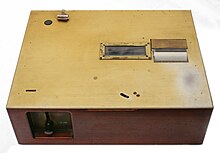


Teaching machines were originally mechanical devices that presented educational materials and taught students. They were first invented by Sidney L. Pressey in the mid-1920s.[1] His machine originally administered multiple-choice questions. The machine could be set so it moved on only when the student got the right answer. Tests showed that learning had taken place.[2][3][4][5] This was an example of how knowledge of results causes learning. Much later, Norman Crowder developed the Pressey idea further.[6][7]
B. F. Skinner was responsible for a different type of machine called GLIDER, which used his ideas on how learning should be directed with positive reinforcement.[8] Skinner advocated the use of teaching machines for a broad range of students (e.g., preschool aged to adult) and instructional purposes (e.g., reading and music). The instructional potential of the teaching machine stemmed from several factors: it provided automatic, immediate and regular reinforcement without the use of aversive control; the material presented was coherent, yet varied and novel; the pace of learning could be adjusted to suit the individual. As a result, students were interested, attentive, and learned efficiently by producing the desired behavior, "learning by doing".[9][10]
There is extensive experience that both methods worked well, and so did programmed learning in other forms, such as books.[11] The ideas of teaching machines and programmed learning provided the basis for later ideas such as open learning and computer-assisted instruction.
Illustrations of early teaching machines can be found in the 1960 sourcebook, Teaching Machines and Programmed Learning.[12] An "Autotutor" was demonstrated at the 1964 World's Fair.[13]